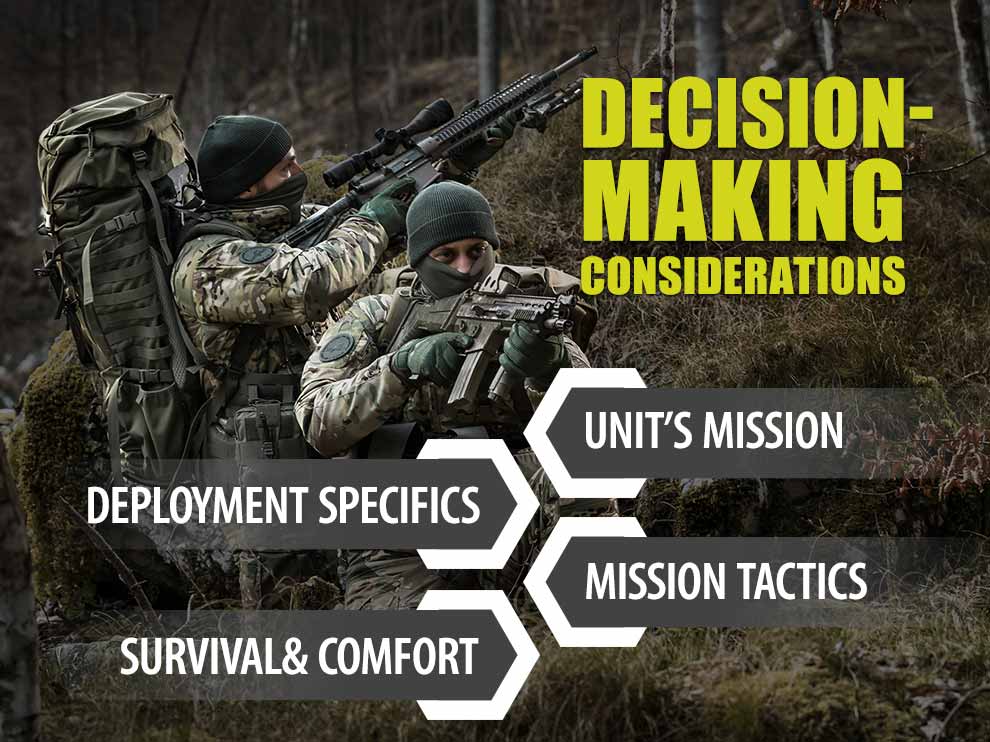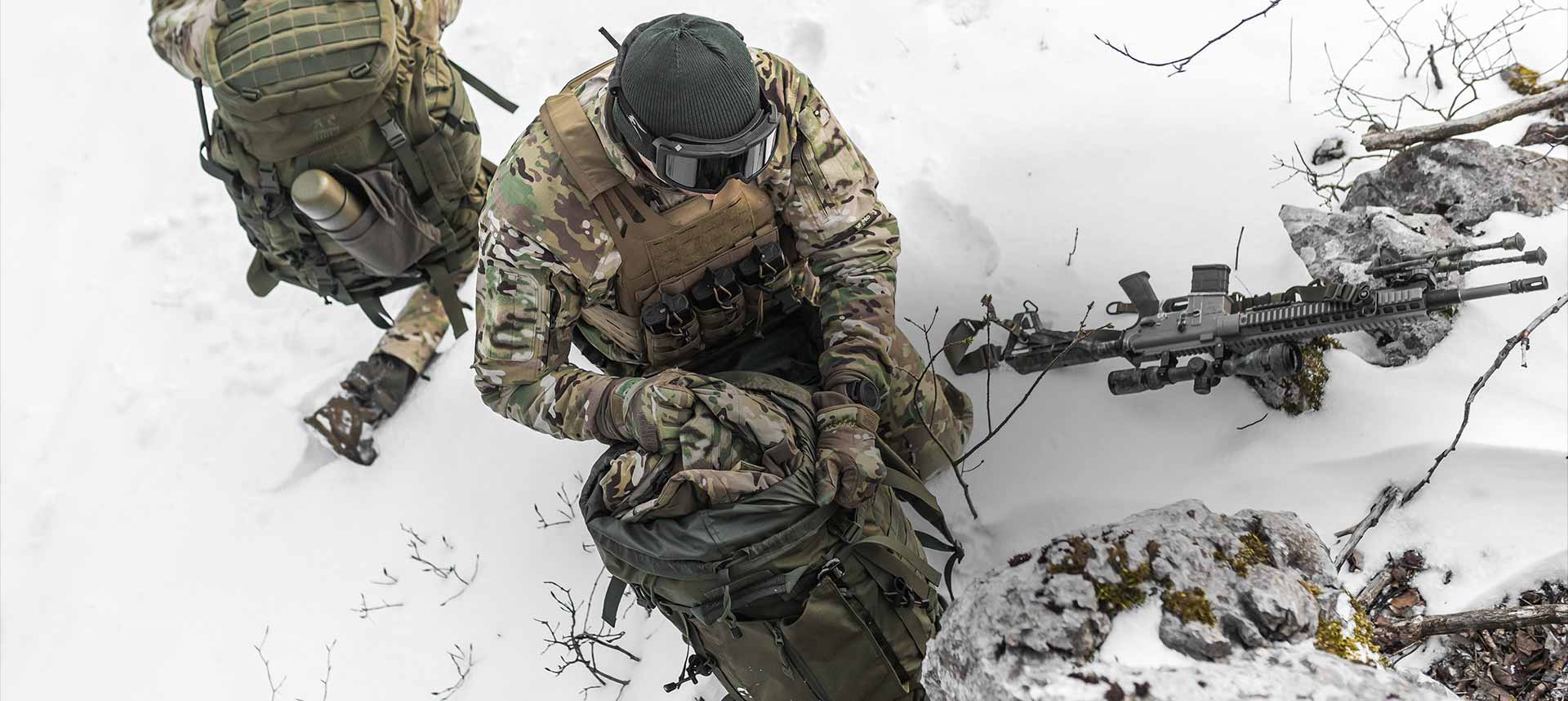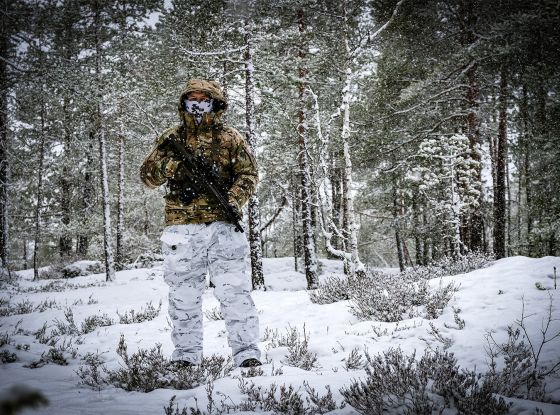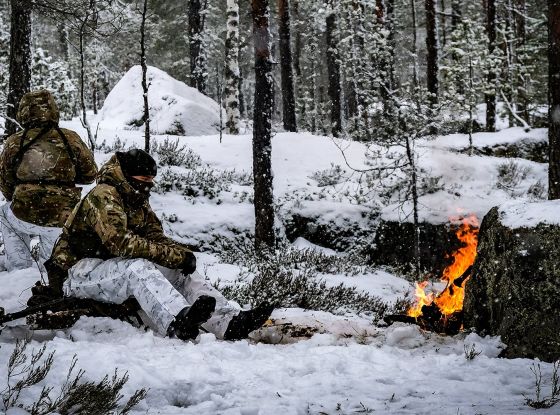When packing for deployment, start by making a list of all your mission-critical and mission-essential gear. This list must be as complete as possible, which means you need to consider all scenarios—including those in which your hands and feet will be getting cold and wet.
In this blog post:
The main thing to remember is that each item you pack ahead of deployment must in some way be capable of contributing to your survival for a bare minimum of 24 hours in the event you and/or your unit become lost or cut off at any point during the mission. Should something like that occur, you’ll only be able to rely on that which you’re carrying with you. So, before you start packing, you must carefully consider what’ll go inside your rucksack, since there’s only so much in the way of food, water, ammunition, and other essentials you can take along.
How to decide what to pack
The contents of that 24-h pack you’ll be lugging on your back may need to last more than a day, depending on whether the mission goes into overtime or—if you end up lost or isolated—on how long it takes to extricate yourself from that situation. So, you need to consider all the possible scenarios that could cause you to be on your own for an extended time, all the possible scenarios you could find yourself in should any part of the mission continue beyond 24 hours. Because you never know what’s going to happen until it happens, it pays to be prepared as best you can.

With that in mind, there are three major things to consider as you draw up your packing list for deployment.
Consider deployment specifics
- Mission duration
- Mission transport mode
- Operational environment
Mission duration
If command doesn’t tell you how long the mission will run, use your brains to make an educated guess. A 24-hour duration is typical, but so are 48- and 72-hour missions. For discussion’s sake, let’s call the 24-hour version a short-duration mission and everything beyond that a long-duration mission. The requirements to ensure your survival in a short-duration mission are obviously different from those of the long-duration type. On a short-duration mission you’ll need a smaller rucksack and can afford to leave behind gear you’d want to have if you were carrying a larger backpack on a long-duration mission.
Mission transport mode
Next, think about how you’ll be inserted and then moved from point to point during the mission. If you’re for the most part going to be riding aboard surface vehicles (Humvees, for instance) you could potentially pack more gear than you would if you’re primarily going to be hoofing it (that is, marching) to your objective.
But it’s a whole different story if we’re talking about rotary/fixed wing transportation. Helicopters and cargo planes, they all have limits as to how much weight each passenger can bring aboard. Doesn’t matter if you’re doing an airborne operation (HI-LO, HI-HO, and static line)- too heavy and that aircraft isn’t getting off the ground. So, depending on the aircraft’s type, size, fuel load, and other factors, you may need to trim the list of items to be placed in your backpack. For example, you may be able to bring only a small backpack because there’s no room aboard the aircraft to stow your bag except in the space between your legs (you’ll find yourself occupying a world of hurt if you’re forced to sit for endless hours in the sky with your limbs splayed wide by the presence of a huge rucksack). However, you may be able to bring that larger backpack if there is available stowage for it and the aircraft is travelling light on fuel (thus allowing it to fly with more weight aboard).
One more point about foot transportation. When you’re going to be slogging from point to point, you need to keep in mind that your backpack—and everything in it—will be mounted over your shoulders and across your back the entire time. Could be brutal, depending on how you’ve packed it. But it could also be just the ticket to ensure your survival because that rucksack is going to be with you every step of the way and will contain (or ideally should contain) everything you need to stay on task. You’re not going to be dependent on air or surface transportation to come back later with whatever you chose to or were forced to leave behind.
Operational environment
Going on foot instead of by some other mode of transport also means that you’ll be more exposed to the environment in your theatre of operations. If that environment is an unfamiliar one, look it up on Google or whatever intel source you customarily rely upon. You need to know before you start packing whether you’re headed to a place where you’ll be greeted by low, moderate, or high temperatures and humidity. You won’t want to be caught unprepared for freezing cold when all you’ve brought with you are some lightweight combat shirts. Similarly, you won’t want to be shocked by how hot it is—and you made the mistake of packing your finest gear for cold weather.
And, of course, you need to know in advance what the environment currently looks like: forest, desert, or something in between. That matters when it comes to what to pack because you’ll likely regret it if you bring a Brown Grey BDU to a place that’s lush with green trees. In other words, fill your rucksack with gear that helps you blend in with the surroundings, not stick out like a sore thumb.
Consider mission tactics
- Mission-critical gear
- Mission-standard equipment
Mission-critical/-essential gear
In determining what to pack, you further need to consider the dictates of the mission and your role in fulfilling them.
Ideally, your packing choices should include the exact right pieces of equipment for the precise task or tasks you’ll be assigned to execute at each stage of the mission. On this list might be a first-aid kit, NVGs, ammo, signal cards, and more.
Then, once you’ve made those selections, you must figure out how to organize them in your pack so that you—or your buddy—can easily retrieve them when needed.
Potentially, there’s a lot of gear that could qualify as “mission critical.” To help you narrow the list so that the contents of your backpack and pockets are limited to just those items you really need for mission success (and a return to base alive), think about how your op would be affected were you to leave behind each of the items meriting the label “mission critical.” For example, would you be able to find your way to the objective without the aid of a GPS device? Could you hang in there for at least 24 hours with only one water bottle rather than three? Does that fire-starter kit make sense if the night temperature in your theatre isn’t expected to drop below 22 degrees Celsius (72 degrees Fahrenheit)?
This also might help narrow the list. Items that go into your pack or pockets count as mission critical if they increase (not reduce) your speediness, promote (not hamper) your agility, maximise (not minimise) your efficiency, conserve (not waste) your strength, and abet (not ruin) your ability to be and remain concealed.
Mission-standard equipment
Some items you’ll have no choice but to carry because your commander will tell you to bring them. These are your mission-standard items (they vary from unit to unit). But even though you’re obliged by those above you to pack them, you still need to take mission-standard equipment into account as you decide what else you’ve got available capacity to carry.
Consider your unit’s mission
- Personal speciality mission-specific gear
- Squad/unit mission-specific gear
Personal speciality mission-specific gear
Your packing list will, naturally, reflect the role you play as a member of your unit. For example, if you’re the combat medic, you’ll be expected to carry—above and beyond the gear and supplies needed to keep yourself going—the items it’ll take to treat anticipated casualties. Similarly, if you’re the comms guy, your rucksack would likely include extra batteries, cables, and maybe a spare satellite phone. Or, if you’re the one who operates the belt-fed 50-cal machine gun, then it’s probable your list would include replacement parts for the weapon and its mount should any of the original components fail during the mission.
Squad/unit mission-specific gear
Certain equipment specific to the mission is typically shared among the members of the squad and/or unit. For example, if the team is bringing a 60mm mortar to the party, each member may be given one or more mortar rounds to carry. This sort of load-distribution practice is something you’ll need to factor in as you make your own individual choices for what to pack.
Consider gear for survival and comfort
- Mission-specific tactical clothing
- Food and water
By this point, your packing list might easily contain enough items to fill up two-thirds of your rucksack and pockets. What else should you consider carrying in the space that remains? Three things come immediately to mind: clothing that will keep you warm, dry, comfortable, and performing at your peak despite the severity of conditions; extra food that will give you energy and endurance; and extra water that will help you stay properly hydrated. But don’t go overboard with any of these items, especially if the mission calls for you to be light and fast.
Mission-specific tactical clothing
Keeping hands, feet, and the rest of your body comfortably warm (or cool, if it’s summer) and dry is crucial for the sake of being able to perform at your best. In winter, this means layering up against frigid temperatures. Ordinarily, layering up requires that you bring extra garments. However, you can avoid the need to bring additional clothing if the garments you choose are thermally insulated (even better if they also are lightweight and breathable). That said, do by all means plan to carry at least on spare set of pants, socks, and gloves because those garments will despite your best effort get wet and need to be changed.
BREATHABILITY AND THERMAL INSULATION
Since weather is unpredictable, you should plan to pack clothing that will be appropriate no matter the conditions you encounter. The problem, again, is the limited space available in your rucksack and the need to minimise the weight you carry. The solution is to pack clothing that’s thermally insulated but also breathable. Such garments are capable of keeping your body at its ideal core temperature regardless of whether you’re operating in a hot or cold environment with low or high humidity (or precipitation). In other words, one piece of clothing covers you against the extremes and everything in between while also letting you pack light and small.
TIGHT VS LOSE-FITTING TACTICAL CLOTHING
Ultimately, it’s going to come down to personal preference. Do you like wearing clothing that’s loose-fitting or clothing that hugs your body? Believe it or not, tight-fitting tactical clothing typically offers better breathability than does the loose-fitting sort. The explanation is that body vapour from your skin transfers directly through the fabric to the outside air; the absence of space between your skin and the outside air deprives the tight-fitting garment of a way to store heat. By the same token, a loose-fitting garment allows a space to exist between your skin and fabric—this pocket of air traps heat and, moreover, prevent body vapour from quickly transferring to the outside air.
Food and water
Imagine having to ditch your backpack or just plain losing it during the mission (for example, you forget you stowed it in the Humvee and forgot to retrieve it before the Humvee drove off). If you packed all your food and water in that carry-along, you’re going to have to forget about eating and drinking for the duration (unless a buddy shares with you, but that won’t happen if you’re totally on your own). Given that this situation is a possibility, it’s advisable to park at least some of your food and water in your pockets. That means you need to consider not only which food-and-beverage items to bring but which of them will go in the backpack and which of them will go in your pockets.
Conclusion
Depending on the nature of the mission you’re about to embark upon, the hardest thing may be to pack so small that you can fit everything you’ll need for 24 hours inside that one 24-h pack (plus your pockets). It can be done, but it requires good planning. And not just good planning, but thoughtful planning. You need to be initimately familiar with the mission objectives, where you’re going, how you’ll be getting there, what kind of conditions you’ll encounter once you arrive, what specific tasks you and your squad or unit are expected to perform, and what your options are for clothing, food, and water. This blog post just scratches the surface of the question of what to pack—for more intel on this subject, please watch this helpful video BEER:30 - Pack efficiently.




